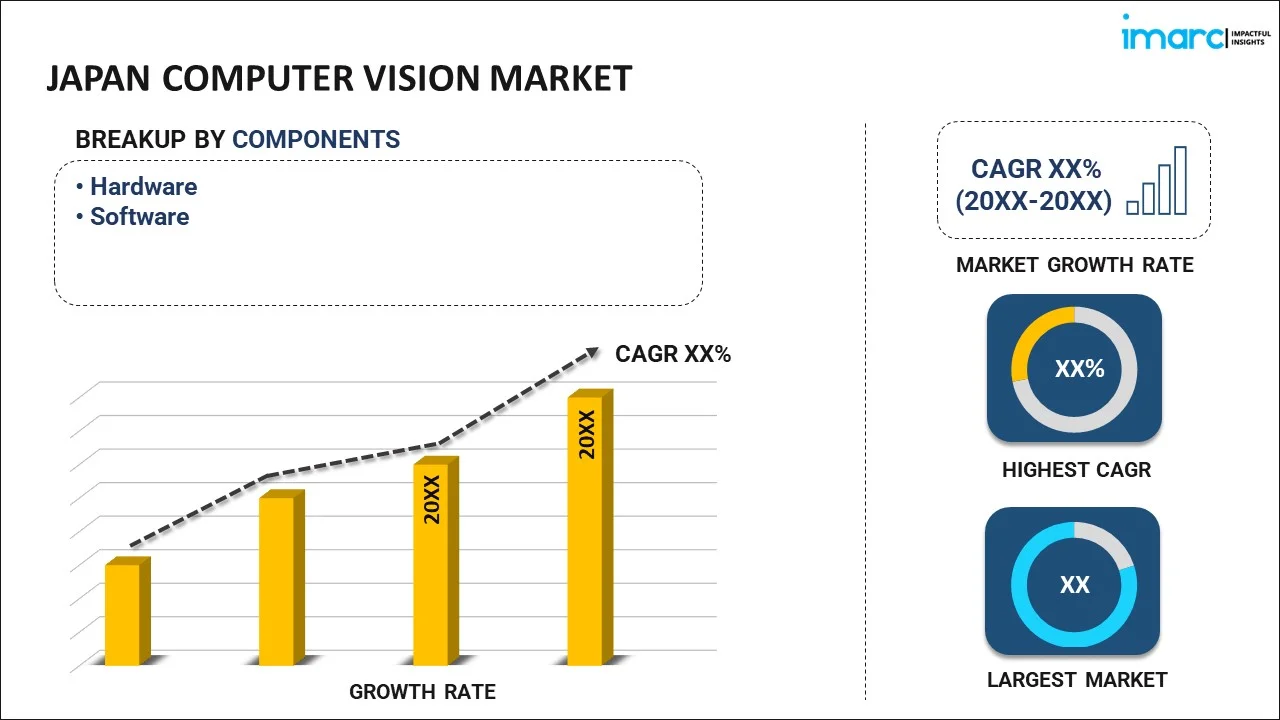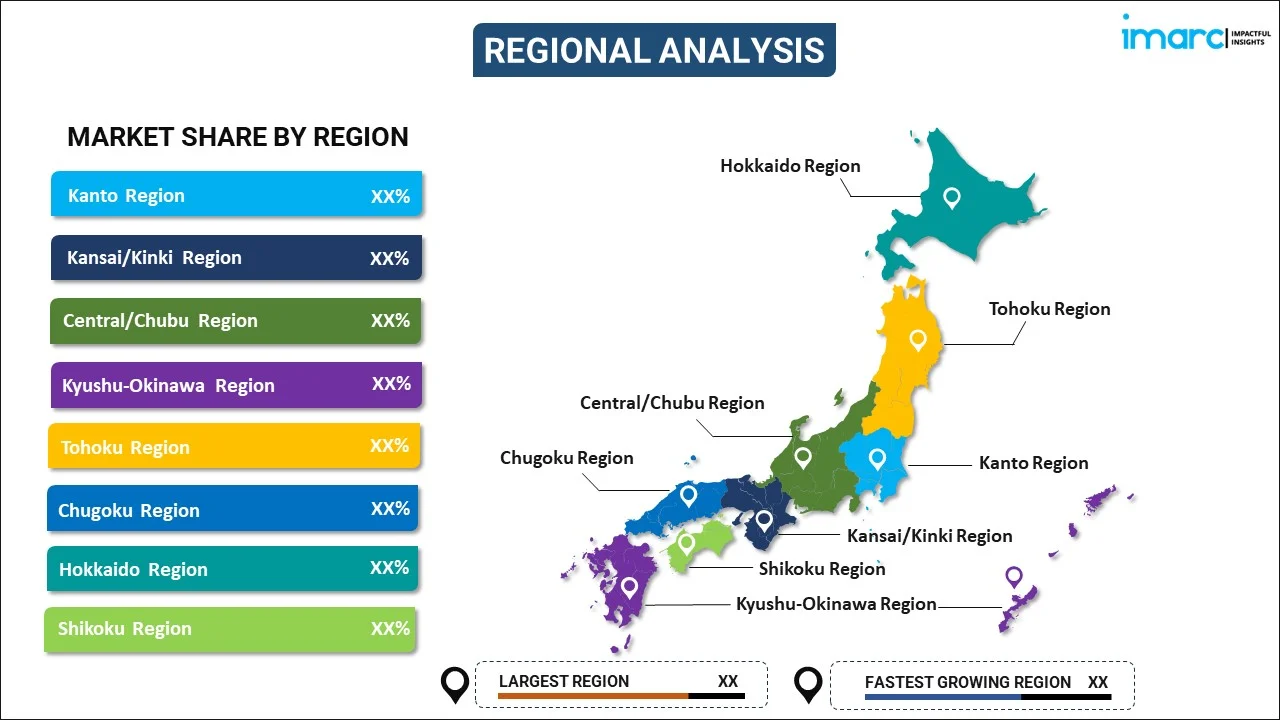
Japan Computer Vision Market Report by Component (Hardware, Software), Product Type (Smart Camera-based, PC-based), Application (Quality Assurance and Inspection, Positioning and Guidance, Measurement, Identification, Predictive Maintenance, 3D Visualization and Interactive 3D Modelling), Vertical (Industrial, Non-Industrial), and Region 2025-2033
Market Overview:
Japan computer vision market size reached USD 1.2 Billion in 2024. Looking forward, IMARC Group expects the market to reach USD 2.8 Billion by 2033, exhibiting a growth rate (CAGR) of 9.88% during 2025-2033. The increasing advancements in deep learning algorithms, particularly convolutional neural networks (CNNs), which have revolutionized computer vision by enabling more accurate object detection, image recognition, and segmentation, are driving the market.
|
Report Attribute
|
Key Statistics
|
|---|---|
|
Base Year
|
2024 |
|
Forecast Years
|
2025-2033 |
|
Historical Years
|
2019-2024
|
| Market Size in 2024 | USD 1.2 Billion |
| Market Forecast in 2033 | USD 2.8 Billion |
| Market Growth Rate (2025-2033) | 9.88% |
Computer vision is a field of artificial intelligence (AI) that enables computers to interpret and understand visual information. It involves the development of algorithms and models that allow machines to analyze images and videos, just as humans do with their eyes and brains. Computer vision systems can perform various tasks, such as object detection, image classification, facial recognition, and even complex tasks like autonomous navigation for self-driving cars. These systems use techniques like image processing, deep learning, and neural networks to extract meaningful insights from visual data. Computer vision finds applications in numerous domains, including healthcare (medical image analysis), surveillance (security and facial recognition), the automotive industry (autonomous vehicles), and manufacturing (quality control and defect detection). It has the potential to revolutionize industries and improve daily lives by providing machines with the ability to see, interpret, and interact with the visual world.
Japan Computer Vision Market Trends:
The computer vision market in Japan is experiencing unprecedented growth, driven by several key factors. Firstly, the increasing demand for automation and efficiency across various industries has propelled the adoption of computer vision technology. Moreover, the proliferation of smart devices, including smartphones and IoT sensors, has generated vast amounts of visual data, necessitating advanced computer vision solutions for meaningful analysis. Furthermore, the rise of AI and machine learning has significantly enhanced the capabilities of computer vision systems. These technologies enable machines to process and interpret visual information with remarkable accuracy, revolutionizing sectors such as healthcare, manufacturing, and autonomous vehicles. In addition to these factors, the escalating need for contactless solutions in sectors like retail, healthcare, and logistics is further boosting the computer vision market. The integration of computer vision in surveillance and security applications has also contributed to its expansion. Lastly, governments and regulatory bodies in Japan are recognizing the potential benefits of computer vision in areas like public safety and transportation, fostering a conducive regulatory environment for the growth of the market. This, in turn, is expected to drive the regional computer vision market during the forecast period.
Japan Computer Vision Market Segmentation:
IMARC Group provides an analysis of the key trends in each segment of the market, along with forecasts at the country level for 2025-2033. Our report has categorized the market based on component, product type, application, and vertical.
Component Insights:

- Hardware
- Software
The report has provided a detailed breakup and analysis of the market based on the component. This includes hardware and software.
Product Type Insights:
- Smart Camera-based
- PC-based
A detailed breakup and analysis of the market based on the product type have also been provided in the report. This includes smart camera-based and PC-based.
Application Insights:
- Quality Assurance and Inspection
- Positioning and Guidance
- Measurement
- Identification
- Predictive Maintenance
- 3D Visualization and Interactive 3D Modelling
The report has provided a detailed breakup and analysis of the market based on the application. This includes quality assurance and inspection, positioning and guidance, measurement, identification, predictive maintenance, and 3D visualization and interactive 3D modelling.
Vertical Insights:
- Industrial
- Non-Industrial
A detailed breakup and analysis of the market based on the vertical have also been provided in the report. This includes industrial and non-industrial.
Regional Insights:

- Kanto Region
- Kansai/Kinki Region
- Central/ Chubu Region
- Kyushu-Okinawa Region
- Tohoku Region
- Chugoku Region
- Hokkaido Region
- Shikoku Region
The report has also provided a comprehensive analysis of all the major regional markets, which include Kanto Region, Kansai/Kinki Region, Central/ Chubu Region, Kyushu-Okinawa Region, Tohoku Region, Chugoku Region, Hokkaido Region, and Shikoku Region.
Competitive Landscape:
The market research report has also provided a comprehensive analysis of the competitive landscape in the market. Competitive analysis such as market structure, key player positioning, top winning strategies, competitive dashboard, and company evaluation quadrant has been covered in the report. Also, detailed profiles of all major companies have been provided.
Japan Computer Vision Market Report Coverage:
| Report Features | Details |
|---|---|
| Base Year of the Analysis | 2024 |
| Historical Period | 2019-2024 |
| Forecast Period | 2025-2033 |
| Units | Billion USD |
| Scope of the Report | Exploration of Historical Trends and Market Outlook, Industry Catalysts and Challenges, Segment-Wise Historical and Future Market Assessment:
|
| Components Covered | Hardware, Software |
| Product Types Covered | Smart Camera-based, PC-based |
| Applications Covered | Quality Assurance and Inspection, Positioning and Guidance, Measurement, Identification, Predictive Maintenance, 3D Visualization and Interactive 3D Modelling |
| Verticals Covered | Industrial, Non-Industrial |
| Regions Covered | Kanto Region, Kansai/Kinki Region, Central/ Chubu Region, Kyushu-Okinawa Region, Tohoku Region, Chugoku Region, Hokkaido Region, Shikoku Region |
| Customization Scope | 10% Free Customization |
| Post-Sale Analyst Support | 10-12 Weeks |
| Delivery Format | PDF and Excel through Email (We can also provide the editable version of the report in PPT/Word format on special request) |
Key Questions Answered in This Report:
- How has the Japan computer vision market performed so far and how will it perform in the coming years?
- What has been the impact of COVID-19 on the Japan computer vision market?
- What is the breakup of the Japan computer vision market on the basis of component?
- What is the breakup of the Japan computer vision market on the basis of product type?
- What is the breakup of the Japan computer vision market on the basis of application?
- What is the breakup of the Japan computer vision market on the basis of vertical?
- What are the various Components in the value chain of the Japan computer vision market?
- What are the key driving factors and challenges in the Japan computer vision?
- What is the structure of the Japan computer vision market and who are the key players?
- What is the degree of competition in the Japan computer vision market?
Key Benefits for Stakeholders:
- IMARC’s industry report offers a comprehensive quantitative analysis of various market segments, historical and current market trends, market forecasts, and dynamics of the Japan computer vision market from 2019-2033.
- The research report provides the latest information on the market drivers, challenges, and opportunities in the Japan computer vision market.
- Porter's five forces analysis assist stakeholders in assessing the impact of new entrants, competitive rivalry, supplier power, buyer power, and the threat of substitution. It helps stakeholders to analyze the level of competition within the Japan computer vision industry and its attractiveness.
- Competitive landscape allows stakeholders to understand their competitive environment and provides an insight into the current positions of key players in the market.
Need more help?
- Speak to our experienced analysts for insights on the current market scenarios.
- Include additional segments and countries to customize the report as per your requirement.
- Gain an unparalleled competitive advantage in your domain by understanding how to utilize the report and positively impacting your operations and revenue.
- For further assistance, please connect with our analysts.
 Inquire Before Buying
Inquire Before Buying
 Speak to an Analyst
Speak to an Analyst
 Request Brochure
Request Brochure
 Request Customization
Request Customization




.webp)




.webp)












